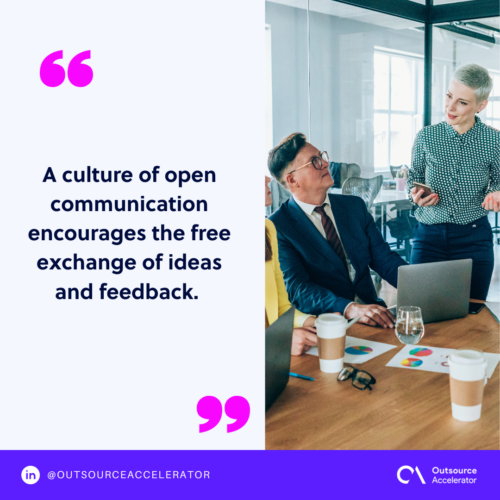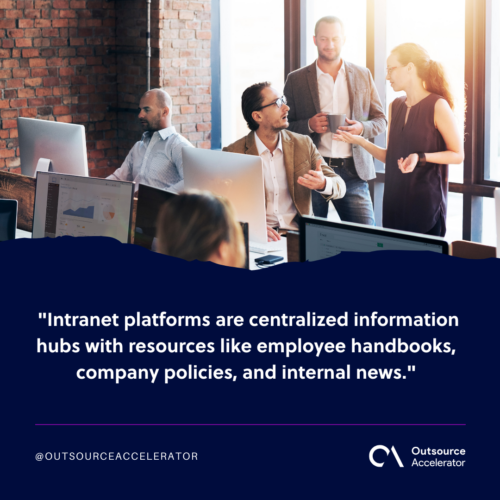How enterprise communication helps businesses

Enterprise communication plays a crucial role in the success of any organization. Strong and effective communication strategies enable smooth collaboration, seamless team relationships, and efficient information dissemination.
As businesses navigate through new models of work and technology, the need for dynamic communication becomes more pronounced than ever before.
From email and instant messaging to video conferencing and project management tools, we explore the various facets of enterprise communication and the benefits of harnessing its power.
What is enterprise communication?
Enterprise communication refers to the exchange of ideas and information within an organization. It comprises various channels, tools, and strategies to facilitate connectivity among your internal audience of employees, departments, and stakeholders.
Enterprise communication involves both internal and external styles. The former focuses on organizational interactions, while the latter concerns engagement with clients, partners, and the broader business environment.
Enterprise communication can take various forms, including written, verbal, and electronic means. Companies must assess which forms are most effective for their workplace.

Benefits of enterprise communication
Enterprise communication is pivotal in an organization’s functionality, contributing to overall efficiency, collaboration, and success.
Here are some benefits of enterprise communication:
Effective collaboration
Enterprise communication fosters collaboration and teamwork among staff and departments. Providing platforms and tools for sharing information breaks down silos and promotes a shared understanding of goals and objectives.
Conflict resolution
Clear and open lines of communication help prevent and resolve conflicts in the workplace. Organizations can address misunderstandings, clarify expectations, and foster a harmonious work environment by promoting effective communication channels.
Enhanced decision-making
Enterprise communication ensures that relevant information reaches decision-makers promptly. This empowers leaders and managers to make informed decisions, driving the organization’s success.
Employee engagement
Employees who feel involved and informed are more engaged in their work. Enterprise communication supports employee engagement by keeping everyone updated, involved, and able to provide feedback.
Increased productivity
Streamlined communication methods reduce delays and eliminate bottlenecks. Quick and clear communication helps prioritize tasks and time management, boosting productivity.
Knowledge-sharing and learning
Enterprise communication platforms facilitate the sharing of knowledge and best practices among employees. This allows for a culture of continuous learning and professional development within the company.
Adaptability and innovation
A culture of open communication encourages the free exchange of ideas and feedback.
This environment is conducive to innovation. Employees feel empowered to share insights, contribute to continuous improvement, and adapt to new opportunities.

Challenges of enterprise communication
While enterprise communication may bring numerous benefits, it often encounters various challenges that can impact efficiency.
Some common challenges include:
Information overload
In an age of constant connectivity, employees can become easily overwhelmed with a relentless flow of messages, emails, and notifications. Filtering through this information overload is challenging, leading to potential information gaps and missed communication.
Ambiguity
Enterprise communication opens the flow of conversation but doesn’t necessarily enhance its quality. Poorly written or unclear communication can persist.
Ambiguous messages can result in errors, delays, and, in some cases, a breakdown of trust among team members.
Language and cultural barriers
Language and cultural differences can pose challenges to effective enterprise communication in organizations with diverse workforces. Differences in communication styles and norms may lead to misunderstandings and negatively impact collaboration.
Geographical and time-zone differences
The rise of remote work introduces its own set of challenges. A company with globally distributed teams may face the challenges of coordinating enterprise communication across different time zones.
This type of work setup may lead to a reliance on digital communication tools, potential feelings of isolation, and difficulties in maintaining team cohesion.
Technological barriers
Successful enterprise communication heavily relies on technology. Outdated or inadequate communication software can impede effective communication.
On the other hand, integrating and adopting new technologies can also present challenges, especially in companies with legacy systems.
Resistance to change
Introducing new communication technologies and methods may face resistance from employees who are accustomed to existing processes. Resistance to change can hinder the adoption and utilization of new tools and platforms.
Overcoming this resistance requires effective change management.
Security concerns
Protecting sensitive information is a critical aspect of enterprise communication. With the increasing dependence on digital tools, organizations must address the security and privacy of sensitive information shared over these platforms.
Security breaches, data leaks, and unauthorized access can pose significant risks to the organization and erode trust among employees and stakeholders.
Addressing these challenges requires a holistic approach considering technological solutions and cultural and practice improvements.
By recognizing and actively working to overcome these obstacles, organizations can foster an environment that is friendly to enterprise communication.
Types of enterprise communications solutions to use
Enterprise communication encompasses assorted types of channels and tools tailored to meet the diverse needs of modern businesses.
Here are a few commonly used solutions:
Email remains a fundamental tool in enterprises. It allows formal communication, document sharing, threaded conversations, and announcements.
Instant messaging
Instant messaging and chat provide real-time communication, enabling quick interactions and informal discussions. It’s useful for quick queries and team collaboration on ongoing projects.
Video conferencing
Video conferencing tools allow for face-to-face communication in a virtual space. This is particularly helpful for teams that are geographically dispersed.
VoIP and unified communications
Voice over Internet Protocol (VoIP) and unified communications platforms offer integrated solutions for:
- Voice calling
- Video conferencing
- Instant messaging
- Collaboration tools
Intranet platforms
Intranet platforms facilitate internal communication, document sharing, and collaboration. They serve as centralized information hubs with resources like employee handbooks, company policies, and internal news.

Project management tools
Project management software tracks progress and task assignments for teams working on projects. These frequently have their own communication systems to ensure everyone involved is updated on the project status.
Enterprise social networks
These platforms mimic social media networks and encourage teamwork and connectivity. They can also be used for marketing updates, customer feedback, and brand promotion.
Mobile communication apps
Mobile apps are used for quick communication between members, even when they’re on the move. This is helpful for those with remote work setups.
The key to effective enterprise communication is selecting the right combination of these tools based on your needs, culture, and the nature of your information.
Improving growth with enterprise communication
Connectivity is the currency of success, and enterprise communication can be a cornerstone of sustainable growth.
By embracing robust communication strategies and leveraging technology, you can unlock a new culture within your organization to propel you ahead of the competition.







 Independent
Independent




